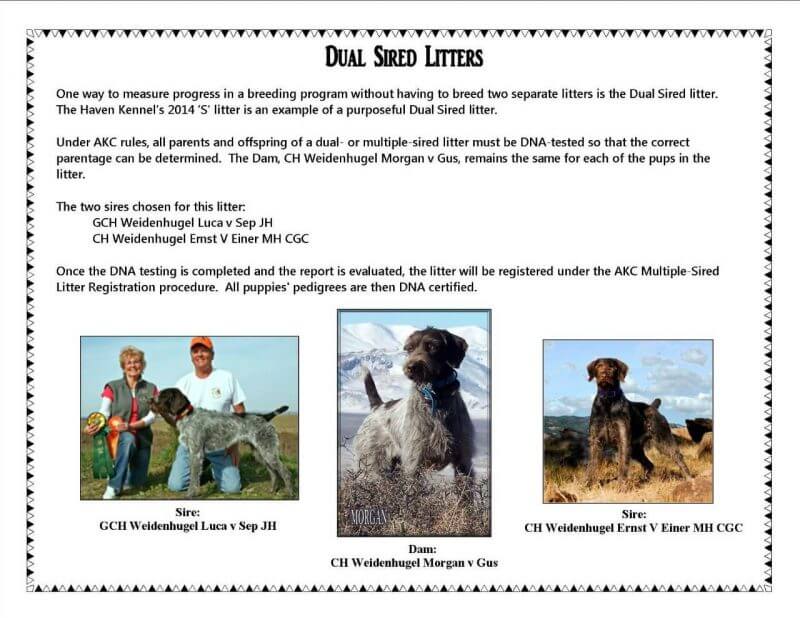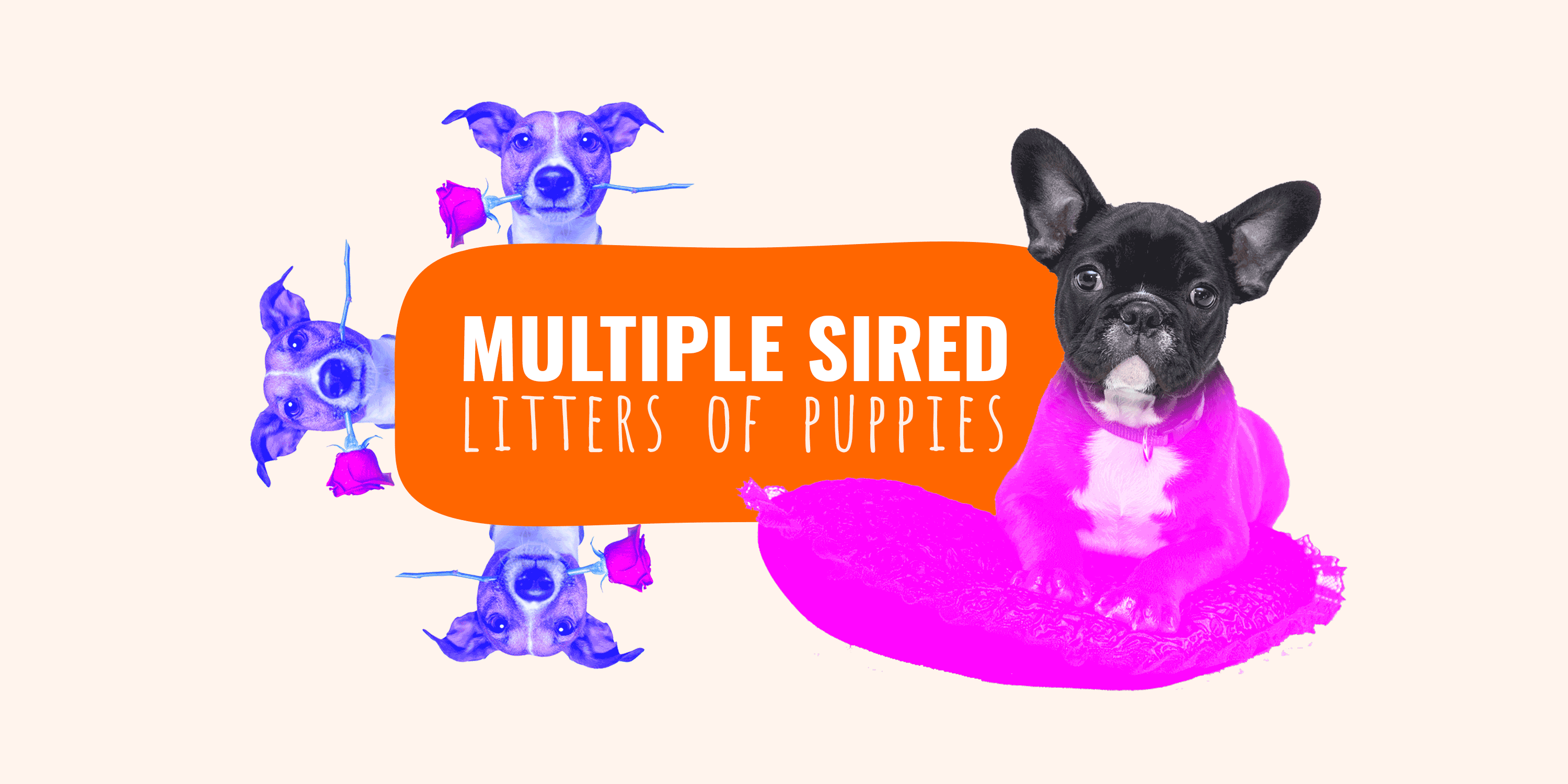A multiple sired litter is a litter of puppies born from the same mother but have different fathers. A stud double is a multiple sired litter having two fathers and a single mother.
Have you ever seen a litter of pups, where some are white, some spotted and some black? And you wondered how that happened? It is probably because of a multiple sired pregnancy. These happen when two or more dogs have mated one female dog. Such breeding results in different looking pups fathered by a different stud each.
However, a lot of breeders are making this marvel of dog genetics, work to their advantage, by inducing multiple sired litters.
What Is a Multiple-Sired Litter?
A multiple-sired litter refers to a group of puppies that are born from the same mother during a single ovulation but have more than one father.
Puppies from the same multiple-sired litter can have completely different appearances from one another. When subjected to a DNA test, they can exhibit completely different genetic profiles. This is a fascinating phenomenon unique to dogs. The female dog can give birth to a litter of 6-8 puppies in one go, each belonging to a different genetic lineage.
What Is a Dual Sired Litter?
A dual-sired litter, also known as stud doubles, is a type of multiple-sired litter where breeders mate the female dog with two purebred males.
Dual-sired litters are often accidental occurrences. Sometimes breeders intend to mate their female dog with one known male, but another male may also mate with her a few days later.
[adwithin]
Advantages of Breeding a Female with Multiple Sires
A lot of professional breeders are adopting the technique of mating their female in heat, with more than one dog for one of the following reasons:
- As a breeder or even a pet parent, if you are confused about whom to mate your dog with, amongst multiple purebred dogs, multiple siring helps a lot. You can simply compare the puppies of two potential sires, side by side, and decide which father you prefer for future matings. It becomes your trial run for the many years to come.
- However, if your beloved dog doesn’t have many fertile years left in her, a multi-sired mating is the best choice. The idea is to squeeze out as many different purebred puppies as they can from a single litter.
- Multiple siring is also a surefire way to ensure that the female’s ovulation does not go waste. Siring with two dogs ensures that you will definitely get a litter, even if one male having fertility issues.
Having said that, you cannot deny that a litter with multiple fathers is often accidental. You cannot keep a watch on your dogs at all times. Plus, the signs of pregnancy in dogs are very subtle and they only begin to show once it is too late.

How Can a Litter of Puppies Have Multiple Sires?
A female dog in heat can produce multiple eggs during ovulation, making her highly fertile and capable of conceiving from each breeding. Interestingly, these eggs are not fully mature when the female ovulates. Instead, sperm from different mates attach to her uterine lining, patiently awaiting the eggs’ maturation.
In most mammals, the eggs mature in the uterine horns, which are prominent organs. Once the eggs are ready for fertilization, the sperm that has been clinging to the uterine lining fertilizes them.
As a result, if there are multiple dogs’ sperm present, the female can give birth to puppies from different fathers during the same heat cycle. These puppies have been genetically proven to have different fathers, and they also vary in appearance and habits.
This incredible genetic phenomenon sets dogs and cats apart in the animal kingdom. The ability to have puppies from a single ovulation is truly remarkable and distinguishes our beloved pets.
How can you tell if a litter of puppies has different fathers? The main clue is their appearance. You may notice variations in color and shades within a single litter.
Sometimes, it can happen that the female mates with another dog while her present eggs are being fertilized. The puppies born from this last mating may be younger and weaker than the others, which is another sign of multiple sires in the litter. For example, the runts of the litter may come from more recent Breedings.
Another way to identify a genetically diverse litter is by observing the different pups’ behavioral traits and habits. However, if you’re extremely curious or a breeder who needs precise details, you can purchase a Breed Identification Kit online or have your dog’s DNA tested.
How Do I Know That My Litter of Puppies Has Different Sires?
Mainly their appearance is what gives them away. You may find color and shade variants within a single litter.
Sometimes, it also happens that the female may have mated with another dog, while her present eggs are getting fertilized. The puppies born through this last mating may be younger and weaker than the rest – this also is a sign that the litter is multiple sired. For example, runts of a litter may be from more recent breedings.
Another distinguishing factor in a genetically diverse litter is also the behavioral traits and habits displayed by the different pups. But if you’re very curious or are a breeder and need to know the exact details, you can buy a Breed Identification Kit online or even get your dog’s DNA tested.
Can a Single Puppy Have Different Fathers?
No, they cannot. A single puppy will have one father and one mother only. However, in a full litter of 6-8 puppies, each puppy can have a different father, but they will still only have one male and one female parent.
Extraordinary events can occur, but their boundaries are limited by the extent of medical science.
The basic explanation behind this is that for a puppy to be born, the mother undergoes ovulation. During ovulation, she releases multiple eggs. She mates with a male dog, who releases his semen into her. The semen contains numerous sperm cells. One sperm cell fertilizes one egg, initiating the formation of a fetus. There is no space for additional sperm cells to meet the egg.
How Do You Register a Multiple-Sired Litter?
The registration of multiple-sire litters is possible with the American Kennel Club but it follows a different process than more regular litters. The process depends on whether this special breeding is intentional or accidental.
[adwithin]
Intentional Multiple Sire Litter
If the multiple-sired litter was induced under supervision to breed a genetically diverse offspring, the rules to register the litter are as follows:
- Pay special fees
- Get the parentage determined only using the American Kennel Club’s DNA profile program
- If using frozen semen to attempt a multiple sired litter, you must first contact AKC DNA operations to get details of paternity determination of the frozen semen
Accidental Multiple Sire Litter
If your female dog’s litter is accidentally multiple sired, which is very common, the rules change. In the case of a surprise stud double or multi-sired puppies being born, one must:
- Obtain a DNA test kit to match suspected sires with the puppies
- DNA samples taken via cheek swabs are to be taken, bagged carefully and mailed at the earliest to the AKC.
- If the possible sires are related, determining the genealogy can be tricky and more tests may be required.
- Once the DNA has been determined, the AKC will send the samples with the reports back to the owner or breeder. At this point, you can either choose to evaluate the breeds of the puppies yourself, using the evaluation form available on the AKC website. Or, you can get the AKC to do it for you, for a fee of $40.
If the DNA test confirms that the litter was sired by a single dog, then regular charges to register will apply which are $25 base charge and $2 per puppy.
So a litter of six puppies sired by one dog will cost $25 + $12 = $37
However, if the puppies are found sired by multiple dogs an additional fee of $200 is charged. Thereafter, for each sire, a base fee of $25 is charged and for every pup born from that sire, a regular fee of $2 is charged.
So, for a litter of six puppies sired by two dogs, the fees will come to: $200 + $25 (first sire) + $25 (second sire) + $12 (six puppies) = $260
Earlier, the AKC disallowed the registration of litters that were sired by more than one father. However, starting 1998, this has changed.
